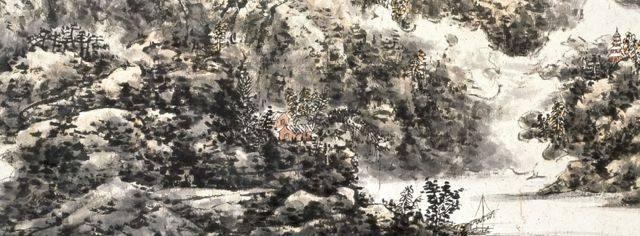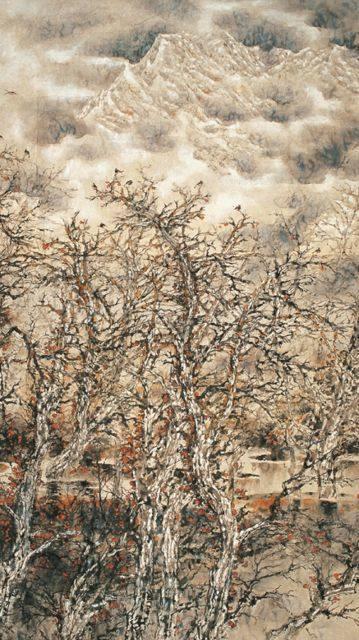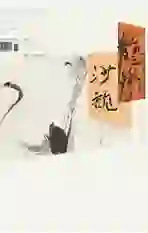The Paintings of Bashu
2014-04-29MiLi
Mi Li


I
Located in northern latitude 30 degree, this region is known as a mysterious belt of the earth. Natural landscape here is magnificent, variable and full of endless mystery of the nature. In the vast continent of Asia, the Yangtze River is like a huge dragon settling on this geographical boundary. When river water rolls ahead from lofty South Tibetan Plateau and flows towards the downstream plain, a huge mountain intercepts roaring river so as to form beautiful scenery including surrounding water before the mountain, rugged gorge in the mountain and broad river surface and turbulent flow at the foot of mountain. Such mountain is Witch Mountain. Here is Bashu region in China.
The God often creates numerous absolutely beautiful landscapes. With a momentum of spurting volcano, clank steel frame and tender feelings are melted into its creation. The beauty of Bashu region thus integrates imposing manner of the north and delicate beauty of the south. Suddenly rising peaks are continuous and dense, or lofty and steep, or beautiful and graceful; the river is surrounded by the mountain and flows in a twisted way, and it is as imposing as a rising rainbow in dynamic state and very tranquil in static state. The slope here is covered with dense grasses, the mountain is full of lush trees, the firs and pines wave in ups and downs and the stretches of bamboos are as vast as the sea; bizarre rocks are distributed along the banks, quiet creeks coexist with ancient trees, colorful stones show a wonderful basin landscape and crisscrossed karst caves form a fine underground view.
When everything just goes well, the God opens cloud tank and splashes swiftly appearing and disappearing clouds, hazy fog, gorgeous ray of rosy clouds, and quickly changeable atmosphere. The wonder of Bashu can be described as different weather conditions within five kilometers. The plateau is frozen with white snow, while peaches and plums have been blooming in fragrance in the basin. The wonder of Bashu also lies in tranquil and beautiful brightness of the sky and shadows of the clouds, such landscape is combined with marvelous mountain to generate an illusory realm, and it is integrated with countryside and downtown streets to bring a splendid mans world.
The God hereto “seals” such a unique creation with precipitous and steep ridges and peaks, rugged rocks and rising waves. Therefore, in a thousand years, those people who have a tour in Bashu region all heave a deep sign: “Walking on the Shu Road is more difficult than going up to the blue sky!”

II
Years and years after Hongmeng, Bashu seems to be “a recluse” in this complicated world. “Have passed forty-eight thousand years, and few since then have passed its border to Qin.” The natural barrier in physically geographical conditions is destined and can yet be regarded as a good luck. For this purpose, Bashu region has its characteristic landscape and cultural background.
Originated from Sanxingdui in Guanghan City 4,800 years ago, the ancient Sichuan civilization bears the beginning of Chinese soul silently. Therein, the extremely exaggerated human face image with extruding eyes, which is domineering, uncanny, humorous and bizarre, reveals that Bashu culture is full of fantastic & diverging imagination and mysterious & romantic aesthetic sense. Till Eastern Han Dynasty, Zhang Daoling founded “the Five Pecks of Rice Sect” in Heming Mountain in Xishu famous for a winding path leading to a secluded place; Indian Buddhism was also rooted in Bashu as southern silk road was opened; intimate contact between foreign religions and local religions made imaginative thinking character of Bashu integrating immortality and deep meditation emerge. In addition, numerous nationalities and diversified styles form beautiful, magical and gorgeous landscape cultures.
The footprints in space and time are connected in series to present quietly flowing culture core of Bashu. Such culture is featured with noteworthy & independent spirit and surging & rich beauty inside. Thus, there is ancient Chang Hongs pride by “using supernatural beings to drive all princes”, Sima Xiangrus lofty passion to break through everything in his poem, Li Bais arrogance just as “even though the emperor called him, he did not embark”, Su Shis honest abidance, Liao Pings individuality expressed as “I understand and inherit six classical arts”, Guo Moruos arbitrariness in destroying everything and“creating” everything… Local people of Bashu are sometimes vigorous and unrestrained, and sometimes alert, smart and humorous. The preference of “flavor” and “hot taste” on the tip of tongue brings a comfort for us and such passion just corresponds to their free and aggressive feeling apart from calm life.
The mountain will cultivate human nature and the people will display the spirit of mountain. Mountain, rivers and human beings form a spiritual homeland that nourishes spirit, emotion, dream and creation here.
III
The creation of Bashu people has a unique style in Chinese painting filed.
The paintings of Bashu enjoyed its first golden age during the period from the Five Dynasties to Song Dynasty. Numerous outstanding painters were gathered in Hanlintu Painting Academy which was the earliest painting academy founded here in China. Huang Quan, as a leading figure, was famous for his excellent coloring and exquisite strokes, depicted flowers and birds in “invisible ink marks to form colorful painting” (Mengxi Bitan by Shen Kuo), pioneered the painting of flowers and birds in fine brushwork and formed a grand situation that “the School of Huang Quan Painting dominated the art circle in Northern Song Dynasty for about one hundred years. Its influence is continued up to now. Based on exact theories and practices, the literati painters represented by Su Shi and Wen Tong in Northern Song Dynasty liberated the painting at the hands of “craftsmen” and inspired the journey of ink painting “towards inside”. Deng Chun could not help signing: “although Bashu region is remote, but the painters there are more than other regions, so that the culture of Bashu is prosperous!”
The beauty of Bashu scenery including flowers, trees, grasses, hills and gullies structures the real image for the painters. Zhang Daqian acquired the quietness of Qingcheng, Li Qiongjiu seized the grotesque of Emei Mountain, Feng Jianwu was enlightened by boundless and vigorous mountains and rivers and Chen Zizhuang realized natural interest in countryside landscape. Apart from local painters, foreign painters who arrived in Bashu region were also inspired from the landscape of mountains. During the period of Anti- Japanese War, Bashu region, due to the advantage of terrain, became a gathering place of culture and many painters lived there. To depict the vigor, peace, green and strength of Bashu region, Huang Binhong adopted more vigorous and thicker ink in painting. “The far and near mountains are like splashed ink and it is difficult in using rice to present continuous mountains. The heaven and earth of Qingcheng is unrestrained and far-ranging in rain and more artistic inspirations are available in Bashu region. ”His joyfulness is reflected among the lines. Fu Baoshi, who settled at the foot of Jingang Slope in Leshan, observed cloudy heaven and earth, raging wind and rain and misty clouds and fog so as to create “a painting style of scattered strokes” known as “Baoshicun”. In that period, Li Keran, Lu Yanshao, Huang Junbi, Tao Lengyue, Lv Fengzi and other famous artists arrived in Bashu region, acquired inspirations, communicated in painting, jointly molded and improved the paintings of Bashu together with local painters and formed the common sense that “the exquisite scenery is in Bashu region”.
IV
The features of the paintings of Bashu vary with the time. Although these features are hardly revealed, they are still in continuity. The well-known reviewer Jiang Taotian in The Regional Style History of Modern School of Traditional Chinese Painting indicates: “The paintings of Bashu have strong regional style, self-conscious modern aesthetic awareness and deep tradition of modern humanity painting, so the paintings of Bashu should have a promising future.”
The paintings of Bashu are diversified in design. Due to changeable geographical and climate conditions as well as national division and fusion in customs, the painting style of Bashu painters is full of options and uncertainties. However, there is an inner connected line——The awareness to represent mountains, rivers, landscapes, culture and customs in Bashu region. During a long or short living in Bashu, the painters always keep such experience in mind, strive to explore corresponding artistic language, avoid the abuse of ordinary image and state techniques and form a localized creation group.
This group breathes magnificent and romantic mystery of Bashu, carries fantastic imagination from ancient times and releases both heart and feelings. They despise consideration, imitate the nature, state their view frankly, reproduce inner world with the ink and pour out happiness, suffering and belief of a life. If this characteristic is reflected in painting, it will represent queerness, wildness, frankness and humor in manifestation. The queerness is fresh and changeable; the wildness is natural and extraordinary. Such characteristic is originated from the living environment and thinking state of Bashu people. Frankness and humor reveal unrestrained, simple, humorous and alert character of Bashu people. The artistic expression based on regional cultural accumulation makes Bashu painters concentrated on conveying romantic charm and improving interest and they add several strokes to display completion and vigor. Chen Zizhuang is as said above, so is Zhang Daqian, Liu Bojun, etc.
However, Bashu painters have not been restrained by a specific style. They understand the tradition deeply, adhere to long-standing aesthetic ideal in spite of obstruction by mountains, maintain natural alienation for popular style and pompous style, become water reservoir in war and accumulate the power of recovery and revival. In addition, they deal with everything in unconventional way, rely on the geographic advantage where southern and northern cultures are communicated and different talents are gathered, stand in local region, learn widely from other successful experience and are committed to artistic expression full of individuality. Their piquant and valiant exceeding spirit should not be ignored. Modern Bashu painters study the tradition and combine regional styles and features to form a unique style or absorb the essence of western arts, get through both inner and outer, and develop a distinctive school. All these aspects are noteworthy.
Steeped in magnificent spirit of cultural landscape in Bashu region, the painters blend the extraction of tradition and the insight of nature in the strokes to make the paintings of Bashu brilliant and tasteful. On this basis, “the school of Bashu painting” will be wellknown in art circle soon.
